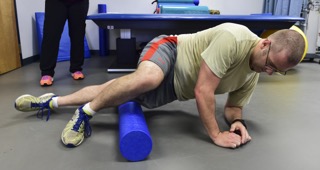Foam Rolling
 Foam rolling as a form of self-massage has been shown to increase range of motion and decrease pain pressure threshold. However, it is unclear whether the roller-induced increases can be attributed to changes in neural responses or muscle responses.
Foam rolling as a form of self-massage has been shown to increase range of motion and decrease pain pressure threshold. However, it is unclear whether the roller-induced increases can be attributed to changes in neural responses or muscle responses.
Study
A study from Canada was conducted to evaluate the effect on spinal excitability of altered sensory (afferent) input via application of foam rolling massage, as measured with the so-called Hoffmann reflex. This study was published in the Journal of Applied Physiology.
Hoffman Reflex (H-Reflex)
The Hoffman reflex (H-reflex) is effectively a muscle spindle reflex (see figure below) at the distal interphalangeal joint of a finger that is excited either mechanically (by a quick “flick” of the joint, usually into flexion) or with electrical muscle stimulation. It is a general measure of the excitability of the central nervous system because the excitability/sensitivity of the muscle spindle reflex can be inhibited (calmed/down-regulated) by upper motor neuron activity from the brain. In other words, the sensitivity of the muscle spindle reflex can be modulated/trained. It is important to note that the H-Reflex is not necessarily a sign of disease. An increased H-Reflex can simply indicate greater nervous system excitability, but it can also occur due to decreased upper motor neuron inhibition caused by an upper motor neuron lesion (disease).

The Muscle Spindle Reflex. Permission: Joseph E. Muscolino. Kinesiology – The Skeletal System and Muscle Function, 3ed (Elsevier, 2017).
Study Design
The study used a randomized design. Three 30-second bouts of foam rolling were implemented on rested, non-exercised, injury-free musculature, with 30 seconds of rest between bouts. The researchers applied foam rolling to the posterior leg (plantarflexor musculature) at three intensities of pain: high, moderate, and sham (no pain). Measures of the H-Reflex were done prior to, during, and up to three minutes post-intervention.
Results
The results showed that foam rolling resulted in significant decreases in soleus H-Reflex amplitudes. High intensity, moderate intensity, and sham conditions decreased soleus H-Reflex amplitudes by 58%, 43%, and 19%, respectively. H-Reflexes induced with high intensity rolling pain were significantly lower than moderate and sham conditions. However, the effects were transient, with an immediate return to baseline following rolling.
Conclusion
This study showed evidence of foam roller-induced modulation of spinal nervous system excitability (in other words, change in the sensitivity of the muscle spindle reflex). The intensity-dependent response observed indicates that rolling pressure/pain perception may play a role in inhibiting the excitability of the reflex. The authors concluded that foam rolling induces neural modulation of spinal excitability. Consequently, down-regulating the muscle spindle reflex results in decreased baseline muscle tone (what is often described as “muscle memory”), which results in greater stretch/elongation potential of the musculature, which can result in increased flexibility / range of motion. Looser musculature can also result in less pain/discomfort in the musculature, hence decreased pain pressure threshold. Therefore, foam rolling can result in greater flexibility and lesser pain pressure threshold of the musculature.
Note: The fact that the results were transient is likely due to the fact that repeated / long term training is necessary to create lasting muscle spindle training with the resultant changes in baseline muscle tone.
This blog post article was created in collaboration with www.terrarosa.com.au.
(Click here for the blog post article: Self Massage Before Stretching Improves Stretching Outcomes.)

